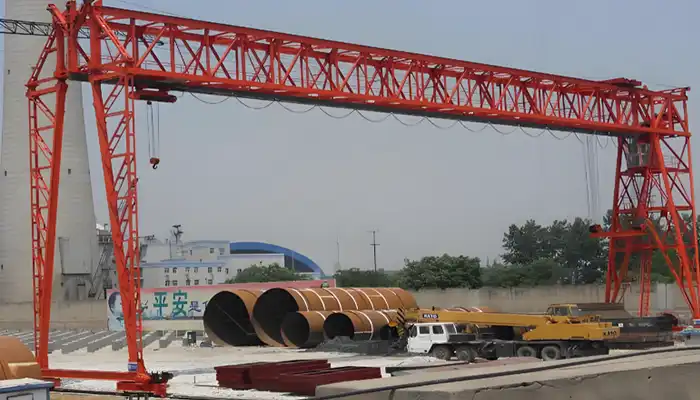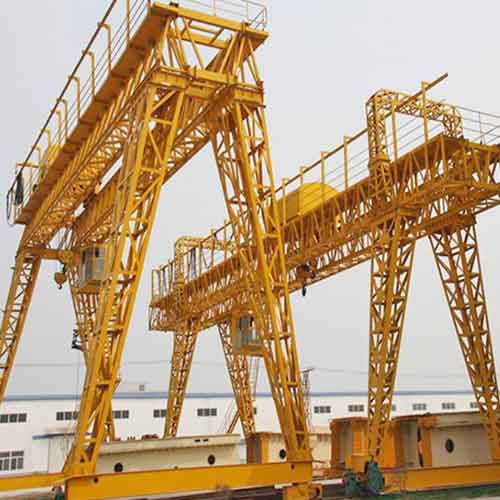
How Truss Design Reduces Wind Load in Outdoor Gantry Cranes
Outdoor gantry cranes are large, heavy-duty lifting machines designed to operate in open spaces. You'll often find them at ports, steel yards, construction sites, and industrial storage areas. These cranes move heavy items like shipping containers, steel beams, and industrial equipment across long spans. Because they operate outside, they face challenges that indoor cranes don't, which makes their design and strength especially important. Applications at a glance: One of the biggest challenges for outdoor cranes is wind. Even a moderate breeze can create lateral forces on the crane, causing swaying, vibrations, or bending in the structure. Coastal regions, open yards, and elevated sites are particularly exposed. Without proper design, wind can affect both safety and operational efficiency. Typical problems caused by wind: The stability of a gantry crane largely depends on how it is built. A strong structural design can resist wind forces, reduce stress on components, and ensure safe operation. This includes choosing the right girder type, adding adequate bracing, and selecting durable materials. A crane with thoughtful design lasts longer, requires less maintenance, and performs reliably under tough conditions. Key points engineers and buyers should consider:Introduction
What Outdoor Gantry Cranes Are Used For
Why Wind Load Is a Concern
How Structural Design Makes a Difference

singleg girder truss gantry cranes for sale 1 ton to 20 ton

double girder truss gantry cranes for 5 ton to 320 ton
Wind Loads on Gantry Cranes
Understanding wind loads is essential for outdoor gantry cranes. Wind can affect stability, safety, and operational efficiency. Proper design and awareness of wind effects help buyers and engineers make informed decisions.
What Is Wind Load?
Wind load is the force that wind puts on a crane. For outdoor gantry cranes, wind can push against the girders, legs, and hoist. Even steady winds can make the crane sway slightly, while strong gusts can cause sudden movements. Understanding wind load is important for safe operation and keeping the crane in good condition.
Why it matters:
- Keeps the crane stable and safe outdoors
- Prevents damage to structure and equipment
- Helps choose the right design for your site
How Wind Affects Gantry Cranes
Wind can impact cranes in several ways. Some effects are easy to see, like swaying, while others, like stress on the metal parts, happen over time.
Common problems caused by wind:
- Swaying and vibrations: The crane can rock or shake, making it harder to lift precisely.
- Stress on girders and joints: Wind pushes on the structure, which can bend or twist beams over time.
- Safety risks: Strong winds can make lifting dangerous and may require stopping operations.
Factors That Change Wind Load
Not every crane is affected the same way by wind. Several things make a difference in how much wind force a crane feels.
Key factors:
- Location and typical wind speeds: Open yards or coastal areas face stronger winds.
- Crane height and span: Taller cranes or longer spans catch more wind.
- Load being lifted: Bigger or heavier loads can act like a sail, increasing sway.
Basics of Truss Design
Understanding truss design is essential for outdoor gantry cranes. Trusses provide strength, stability, and efficiency, making them ideal for long spans and heavy loads while reducing overall weight.
What Is a Truss?
A truss is a structure made of interconnected beams that form triangles. Triangles are naturally strong and resist bending, which makes trusses ideal for crane girders. Using a truss means the crane can carry heavy loads while keeping the overall weight lower.
Key Components:
- Chords: The main horizontal beams (top and bottom) that carry most of the load
- Webs: Diagonal or vertical beams connecting the chords, distributing forces evenly
- Nodes: Joints where chords and webs meet, transferring load efficiently
Common Truss Types in Gantry Cranes
Different truss designs serve different purposes depending on crane span, load, and wind conditions. Here are the main types:
Pratt Truss
- Diagonal members slope toward the center under tension
- Handles medium to long spans well
- Strong and efficient for heavy loads
Warren Truss
- Consists of a series of equilateral triangles
- Simple and cost-effective to build
- Provides a good balance of strength and weight
Lattice Truss
- Multiple small diagonal members forming a lattice
- Extremely rigid and stable under wind pressure
- Ideal for long spans and outdoor use
Why Trusses Are Effective for Cranes
Trusses are popular in crane design because they combine strength, efficiency, and stability.
Advantages of Truss Structures:
- Lightweight yet strong: Reduces the overall weight of the crane while still carrying heavy loads
- Efficient load distribution: Spreads forces across multiple members to reduce stress on any single part
- High stiffness-to-weight ratio: Keeps the structure rigid and prevents twisting or bending
How Truss Design Reduces Wind Load
Truss designs are key to improving wind resistance in outdoor gantry cranes. By combining open lattice structures with triangular geometry, trusses reduce wind forces and improve stability.
Aerodynamic Advantages
Truss girders are not solid—they have an open lattice structure. This design allows wind to flow through the crane rather than hitting a flat surface directly, which lowers the lateral forces acting on the crane.
Benefits of the open design:
- Wind passes through instead of pushing against the crane
- Less overall wind drag compared to solid girders
- Smoother and safer operation during moderate or strong winds
Structural Advantages
Beyond letting wind pass through, trusses improve the crane's structural performance. The triangular patterns distribute forces efficiently, keeping the crane rigid and reducing stress on individual members.
Structural benefits include:
- Wind forces spread across multiple beams rather than concentrating on one
- Triangular geometry increases torsional stiffness, preventing twisting
- Main girders experience smaller bending moments, reducing long-term wear
Practical Examples
Truss designs are widely used in areas where wind is a concern. Real-world examples show how they outperform solid girders in outdoor conditions.
Case highlights:
- Solid girder vs. truss girder: In high-wind tests, solid girders show more sway and bending, while truss girders stay stable
- Ports and open yards: Coastal installations and open storage areas prefer truss cranes because they can operate safely in gusty conditions without sacrificing lifting precision
Design Considerations for Wind-Resistant Truss Gantry Cranes
Designing a truss gantry crane for high-wind environments requires careful choices in truss type, materials, reinforcements, and compliance with standards.
Choosing the Right Truss Type and Geometry
Not all trusses perform the same under wind. The span, height, and intended load of the crane play a key role in selecting the right design.
Considerations:
- Longer spans may need lattice or Warren trusses for rigidity
- Taller cranes should focus on torsional stiffness to resist twisting
- Matching truss geometry to load distribution ensures safety and stability
Material Selection and Thickness
The strength of the crane largely depends on the materials used for the girders and members. Steel quality, thickness, and treatment affect both load capacity and wind resistance.
Practical tips:
- Use high-strength steel for main chords and webs
- Optimize thickness to balance weight and strength
- Consider corrosion-resistant coatings for outdoor use
Reinforcements for Extreme Weather
Extra reinforcements can help cranes survive stronger gusts or harsh environmental conditions. Proper bracing, cross members, and stable foundations make a big difference.
Key reinforcement strategies:
- Bracing: Add diagonal or horizontal braces to improve rigidity
- Cross members: Connect webs for better load distribution
- Anchoring & foundation stability: Ensure the crane's base can resist overturning or sliding under wind pressure
Compliance with Engineering Standards
Following design standards ensures safety, reliability, and regulatory compliance. These standards guide wind load calculations, member sizing, and safety factors.
Standards to consider:
- ISO or FEM: International standards for cranes and structural loads
- Local design codes: Country-specific requirements for wind, seismic loads, and material
- Wind load calculations: Include maximum gusts and operational limits with safety factors
Benefits of Truss Design for Crane Buyers
Truss gantry cranes offer multiple advantages for buyers, including safety, efficiency, and cost savings, especially in outdoor and windy conditions.
Improved Safety and Reduced Operational Risk
Truss-designed gantry cranes handle wind and heavy loads more efficiently. The open lattice and distributed forces reduce swaying and twisting, making lifts safer for operators and surrounding equipment.
Why it matters for buyers:
- Less chance of accidents during windy conditions
- More stable operation with heavy or awkward loads
- Safer work environment in outdoor yards or ports
Lower Maintenance Costs
Because the wind forces and lifting stresses are distributed across the truss structure, individual beams and joints experience less wear and fatigue. This translates into fewer repairs and lower maintenance over the crane's lifetime.
Maintenance benefits:
- Reduced stress on main girders and hoist components
- Less frequent inspections and part replacements
- Lower long-term operational costs
Higher Load Capacity Without Extra Weight
Truss designs allow cranes to handle heavier loads without making the structure excessively heavy. This is especially useful for buyers who need cranes for demanding lifting operations but want to avoid high material and shipping costs.
Practical advantage:
- Can lift heavier steel, containers, or equipment safely
- Keeps crane weight manageable for foundation and runway support
- Optimizes material use without sacrificing performance
Longer Service Life in Outdoor Environments
Trusses are ideal for outdoor use because they resist bending, twisting, and wind forces more effectively than solid girders. This means a truss gantry crane can operate reliably for many years, even in harsh conditions.
Longevity benefits:
- Greater resistance to wind, weather, and operational stress
- Lower risk of structural fatigue or damage
- Extended operational life reduces replacement costs
Conclusion
Truss design is a proven solution for outdoor gantry cranes, especially in areas exposed to strong winds. By allowing air to pass through the open lattice and distributing forces across multiple members, trusses reduce sway, minimize stress on girders, and improve overall stability.
When selecting a crane, it’s important to consider designs specifically optimized for wind resistance. Choosing the right truss type, materials, and reinforcements ensures safer operation, lower maintenance, and longer service life.
For buyers and engineers, consulting with suppliers about custom high-wind truss gantry cranes can make a real difference. Tailored solutions take into account your site conditions, load requirements, and operational needs, giving you a crane that is both reliable and efficient.
Next steps:
- Discuss your yard conditions and typical wind speeds with a supplier
- Review truss options and structural reinforcements for your crane span and height
- Request a customized solution designed for safety, performance, and durability